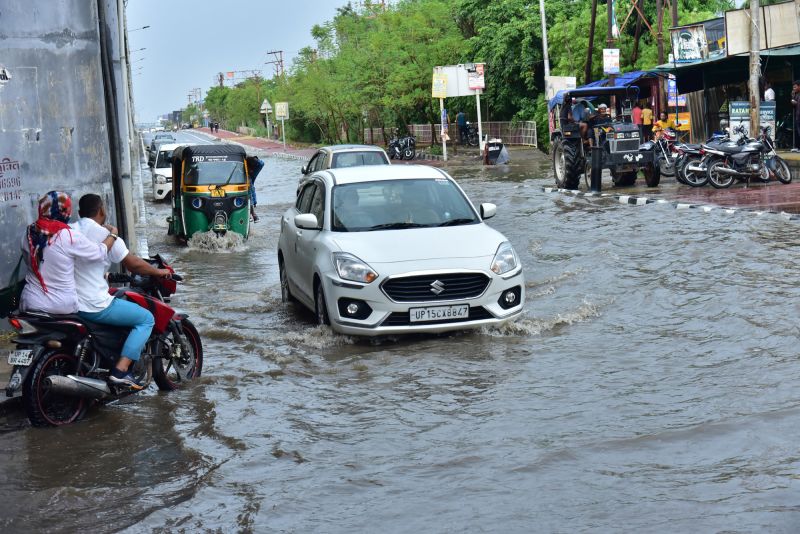Deadly flash flooding due to sudden heavy rains has inundated India’s capital, replacing one of the worst heat waves in Delhi’s history that sent temperatures soaring well above 40 degrees Celsius (104 degrees Fahrenheit).
An observatory in New Delhi on Friday reported 228.1 millimeters (nearly 9 inches) of rainfall in a 24-hour period, the most recorded in a single June day for 88 years and surpassing the city’s average for the whole month, according to the Indian Meteorological Department.
At least 11 people died from the rain and flooding last week, including four people who drowned in submerged underpasses, Reuters reported citing local media.
Heavy rains caused roads to flood, submerged cars and subways and cut power to some parts of the city. Video posted to social media showed waterlogged streets in Delhi as residents wade waist-deep through the floods.
Delhi capital region “is becoming home to extreme weather every season now,” said independent weatherman Navdeep Dahiya on X.
Heavy rain caused a section of roof at New Delhi’s airport to collapse on Friday, crushing one man to death, and injuring eight others. Photos of the scene released by the fire service showed the large white canopy of the roof had plunged to the ground, crushing several cars. One person could be seen slumped under twisted metal in the driver’s seat of one of the cars.
The heavy rains have brought some respite from weeks of blistering heat, with one part of Delhi reaching 49.9 degrees Celsius (121.8 degrees Fahrenheit) in late May — the capital’s highest temperature on record. This year’s scorching heat wave persisted even after the blazing sun had set, with high nighttime temperatures providing little relief.
The Indian Meteorological Department has issued a weather warning until July 4 as heavy rains hit much of India’s northeast, east and northwest coast.
Red alerts, indicating the highest-level threat, were issued for parts of the northeast states of Assam, Meghalaya, West Bengal, Sikkim, Bihar, and Arunachal Pradesh on Sunday.
“Heavy to very heavy rainfall is very likely over northwest, east and northeast India over the next four to five days,” Indian Meteorological Department said Sunday.
On Friday, five Indian army personnel died after their tank got stuck in flash floods while attempting to cross a river during training in India’s northern Ladakh, the army said in a post on X.
“Rescue teams rushed to the location, however, due to high current and water levels, the rescue mission didn’t succeed and the tank crew lost their lives,” the army said.
Heavy monsoon rains have also caused damage in neighboring countries. In Nepal, at least nine people, including three children, were killed after rains triggered landslides in the country’s west, Reuters reported, citing an official from the National Disaster Rescue and Reduction Management Authority.
From no water to too much water
India, the world’s most populous nation, is one of the countries worst affected by the human-caused climate crisis, according to the Intergovernmental Panel on Climate Change – potentially affecting 1.4 billion people nationwide.
The climate crisis is making extreme weather events more frequent and severe, scientists say, and this can be seen play out in climate-vulnerable India which is suffering from extremes of heat, rainfall and other disasters such as cyclones.
While India often experiences heat waves during the summer months of May and June, in recent years, they have arrived earlier and become more prolonged, with scientists linking some of these longer and more intense heat waves to climate change.
New Delhi topped a recent list of hottest capital cities, recording 4,222 days above 35 degrees Celsius in the past three decades – more than any other city analyzed. Between 2014 and 2023, just under half (44%) of days in the Indian capital met that threshold, compared to 35% from 1994 to 2003, and 37% from 2004 to 2013.
Delhi, like many cities in India, is suffering from a water crisis, with acute water shortages and lack of groundwater supply leaving many people to rely on water tankers for their supply of fresh, clean water.
Meanwhile, seasonal monsoon rains usually start in June until September, bringing bands of heavy rains from the southwest that quench fields, nourish crops, and replenish reservoirs. But recent studies have shown India’s monsoons have become more erratic in the past 10 years, due to the climate crisis, posing significant risks to critical sectors such as agriculture, water, and energy.
Last June, nearly half a million people in northeast India were affected by severe flooding after heavy rains battered the region.
“Because of climate change, you will get more extreme rain events, which means more rain in a fewer number of rainy days, rainy hours,” Sunita Narain, director general of Indian research body Centre for Science and Environment, said in a video post on YouTube last week.
“If you look at the data from across India, you will find that many weather stations are already reporting that they are breaking the record of 24-hour rainfall, which means that a city, a region, can get its annual rain, as much as a whole year’s rain, in a matter of a few days or even one day.”
Going from water scarcity to floods is a “cycle that we are beginning to see more and more,” Narain said, adding that it was an opportunity “to make a change.”
In a separate video post on the importance of rainwater harvesting, Narain said, “The only way we can manage floods is when we can build drainage so that our rivers are drained into channels, into ponds, so that excess rain can be held and it can recharge groundwater for the dry season that comes after.”



























